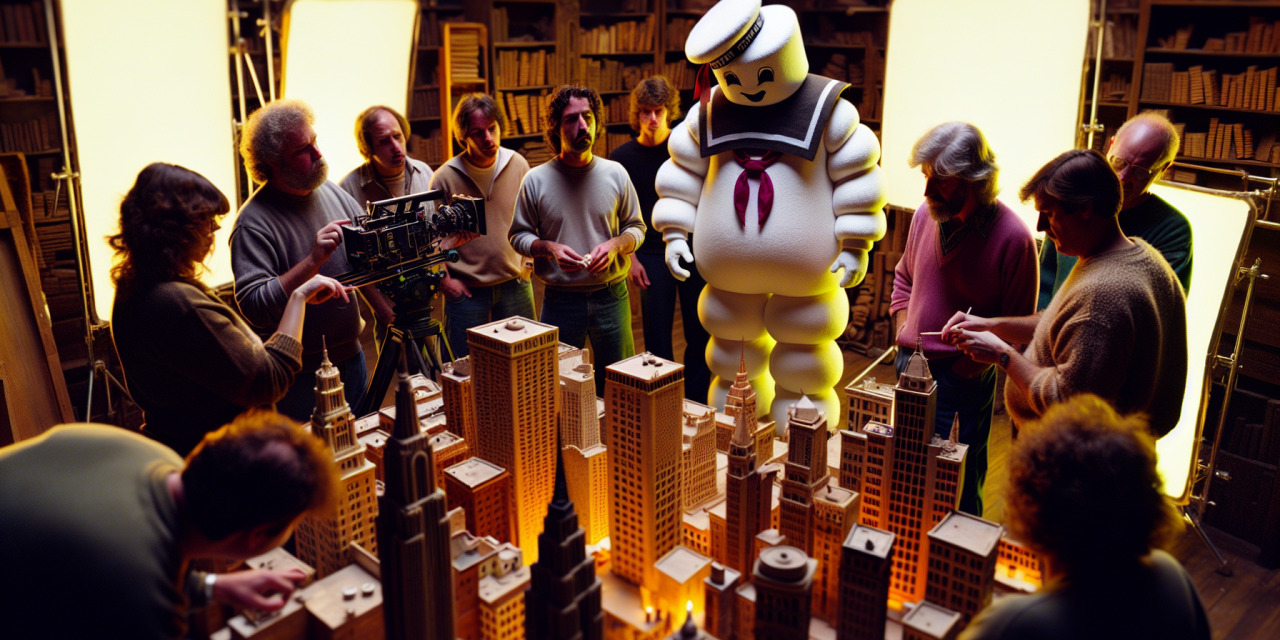Picture this: It’s 1984. You’re part of the special effects team for Ghostbusters, and suddenly the director drops a bombshell on you. The giant marshmallow monster terrorizing New York City—the film’s climactic villain—needs to be completely redesigned. Your sophisticated mechanical creature? Not working. Your complex animatronics? Too expensive. Your elaborate stop-motion sequences? Running out of time. What do you do?
If you’re like the creative problem-solvers behind the Stay Puft Marshmallow Man, you shrug your shoulders and say, “Let’s get someone in a puffy costume and see what happens.”
Sometimes the most elegant solutions are the simplest ones—and that’s a lesson every coder, thinker, and creative problem-solver needs to learn.
When Your Original Plan Melts Away
The Stay Puft Marshmallow Man wasn’t supposed to be a person in a costume walking through miniature New York streets. The original vision was far more ambitious: a towering mechanical creature that would lumber through elaborate sets. But like so many projects—whether you’re building a website, designing a game, or even planning a school presentation—reality had other plans.
Budget constraints kicked in. Time started running short. The mechanical monster just wasn’t working the way everyone hoped. Sound familiar? This is exactly what happens when you’re halfway through coding a project and realize your original approach is way more complicated than it needs to be.
Here’s where the magic happened: instead of panicking or scrapping the entire idea, the team pivoted. They embraced what we might call “pragmatic creativity”—finding the simplest solution that still achieves your goal.
The Beauty of “Just Make It Work” Engineering
Think of the Stay Puft solution as the equivalent of using duct tape to fix a wobbly table leg. It’s not the most elegant engineering solution, but it absolutely works. The filmmakers took a step back and asked themselves: “What do we actually need this monster to do?”
The answer was surprisingly simple: look big, move menacingly, and convince audiences that a giant marshmallow creature was stomping through Manhattan. They didn’t need cutting-edge robotics or Hollywood wizardry. They needed someone willing to wear a puffy white costume and stomp around a carefully constructed miniature city.
This kind of thinking is pure gold when you’re coding. Maybe you originally planned to build a complex database system for your school project, but you’re running out of time. Could you use a simple spreadsheet instead? Maybe you wanted to create an elaborate animation, but a few well-timed transitions would get the job done just as effectively.
Quick-Fix Brainstorming in Action
The Ghostbusters team demonstrated something coders do all the time: rapid prototyping with whatever materials are available. They looked around and said, “What can we actually build right now, with the time and resources we have?”
Their brainstorming probably went something like this: “We need a giant monster. We have costume materials. We have miniature building sets. We have a camera. Can we make those three things work together?” The answer was yes—and the result became one of cinema’s most memorable monsters.
This mirrors the debugging process perfectly. When your code isn’t working, you don’t always need to rebuild everything from scratch. Sometimes you need to ask: “What’s the simplest change I can make to get this working?” Maybe instead of writing a complex algorithm, you can use a library someone else already built. Maybe instead of creating a custom solution, you can adapt an existing template.
The Miniature Magic
One of the most brilliant aspects of the Stay Puft solution was using forced perspective—filming a person-sized costume against miniature buildings to create the illusion of enormous scale. This is like using clever CSS tricks to make a simple website look sophisticated, or using existing functions to create something that appears much more complex than it actually is.
The filmmakers realized that perception matters more than technical complexity. As long as the audience believed they were seeing a giant monster, the actual mechanics didn’t matter. Similarly, if your app works smoothly and looks good to users, they don’t need to know whether you built everything from scratch or cleverly assembled existing pieces.
Why Simple Solutions Often Win
The Stay Puft approach worked so well that it became the template for countless other movie monsters. Why? Because simple solutions are often more reliable, easier to modify, and surprisingly effective. When you’re not fighting against overly complex systems, you can focus on making sure the basic functionality is rock-solid.
In coding terms, this translates to writing clean, readable code that does exactly what it needs to do—nothing more, nothing less. Your first instinct might be to show off with fancy features and complex logic, but sometimes a straightforward approach is not just easier to build—it’s easier to fix when something goes wrong.
Pragmatic Creativity in Action
Embracing the Pivot
Perhaps the most important lesson from the Stay Puft Marshmallow Man is that changing your approach midstream isn’t admitting defeat—it’s smart adaptation. The ability to recognize when your original plan isn’t working and quickly shift to something more practical is a superpower in any creative or technical field.
Next time you’re stuck on a project that’s becoming more complicated than you expected, channel your inner Ghostbuster. Step back, look at what you have available, and ask yourself: “What’s the simplest thing that could possibly work?” You might be surprised by how effective a little creative problem-solving can be.
After all, sometimes the most memorable solutions come not from having unlimited resources, but from making the most of what you’ve got—even if what you’ve got is just a puffy white costume and a lot of determination.
Movie-Making as Problem Solving
Behind closed doors at Industrial Light & Magic, tensions were running high. With just weeks before the Ghostbusters deadline, special effects supervisor Richard Edlund stared at the massive, broken mechanical Stay Puft creature that had consumed months of work and a significant portion of their budget. The 12-foot animatronic monster, designed to be controlled by cables and motors, had proved unreliable—its movements looked jerky and unconvincing.
“We’re not going to make this work in time,” one of the technicians said, voicing what everyone was thinking. The pressure was immense. This was the climactic sequence of the film, and without a convincing monster, the entire movie could fall apart.
That’s when someone—legend has it that it might have been Edlund himself—suggested the radical pivot that would save the production: “What if we just put someone in a costume and film them walking through miniature sets?”
The room went quiet. After months of complex engineering, sophisticated mechanisms, and cutting-edge robotics, the solution they needed was embarrassingly simple. It was like being deep in a complex coding project, debugging for hours, only to realize the fix is changing a single variable or adding one missing semicolon.
But here’s where the real problem-solving genius kicked in: instead of dismissing the simple solution as “too basic,” the team embraced it. They rapidly prototyped a foam costume, built detailed miniature New York street sets, and tested the forced perspective technique. Within days, they had footage that was not only convincing but actually more dynamic and entertaining than their original mechanical approach.
This is the essence of pragmatic creativity—being willing to abandon your complex, “impressive” solution in favor of something that simply works. In coding terms, it’s the difference between writing 500 lines of custom code to solve a problem that could be handled with a 10-line function from an existing library. The Stay Puft team taught us that sometimes the best engineering solution isn’t the most technically sophisticated one—it’s the one that gets the job done effectively, on time, and within budget.
Your Call to Action: Embrace Simple Solutions
So here’s your challenge: Look at your current tech or creative project—whether it’s a website, an app, a design, or even just organizing your digital life. What complicated approach are you taking that could be simplified? What “marshmallow man moment” are you avoiding because you think the simple solution isn’t impressive enough?
Start today. Pick one thing you’re overcomplicating and ask yourself the Stay Puft question: “What’s the simplest thing that could possibly work?” Then try it. Don’t worry about whether it’s the most elegant or sophisticated approach. Focus on whether it gets the job done.
Your projects don’t need to be monuments to your technical prowess. They need to work, ship on time, and solve real problems. Sometimes the best engineering is the kind nobody notices because it just works seamlessly.
Challenge yourself to find the simple solutions hiding in plain sight. Your future self—and your project deadlines—will thank you. After all, if it’s good enough to save Ghostbusters from a giant marshmallow monster, it’s probably good enough for your next coding challenge.








